Table of contents
Performance date: 17 novembre 2018
Documentation date: 30 mai 2021
Version state
Valid
Validation date: 16 janvier 2022
Executions dates of this version
- 17 novembre 2018,
Version documentalist
- meudic (Benoit.Meudic@ircam.fr)
Version realisation
- Yan Maresz (Composer)
- Benoit Meudic (Computer Music Designer)
- Jérémie Henrot (Sound engineer)
Upgrade Motivation
Max8 64bits version
Other version(s)
Detailed staff
- flûte, clarinette, violoncelle, trombone, accordéon, percussionniste, clavier électronique/MIDI/synthétiseur
Channel details
- Number of input channel : 6
- Number of output channel : 5
Electronic equipment list
Computer Music Equipment
-
1 iPad - Tablets
(Apple)
with Mira -
1 Reaper - Music Software
(Cockos)
-
1 Max 8 - Max
(Cycling74)
-
1 Sound Board - Sound Board
for instance fireface 800
Audio Equipment
-
12 Microphone - Microphone
for each instruments -
4 Loudspeaker - Loudspeakers
-
1 ear-monitor - Headphones
for the clicktrack -
1 Mixing Console - Mixing Console
for instance Yamaha DM1000
Work related information
Premiere
- 3 juin 2005, Paris, Auditorium du Louvre, festival Agora
- 2 juin 2021, France, Paris, Cité de la Musique
Publisher :
- édition du compositeur
Realisation
- Benoît Meudic
Work length
- 1 h 15 mn
Useful links on Brahms
- Paris qui dort musique pour le film de René Clair (1924), pour petit ensemble et électronique (2005), 1h15mn
- Yan Maresz
| File | Author(s) | Comment | |
|---|---|---|---|
| Download [2,2 Gio] | Patch _PQD-2021-Max | Benoit Meudic | max patch |
| Download [1,1 Gio] | Patch _PQD-2021-Reaper light | Benoit Meudic | reaper session for sound files and midi triggering |
| Download [592,2 Kio] | Setup IRCAM-PQD-2018-SETUP AND CHANNEL LIST | Jeremie Henrot |
Instructions
Description of the piece:
“Paris qui dort”, is a piece written by Yan Maresz for 6 instruments and live electronics on the silent movie “Paris qui dort” by René Clair.
It was created in Auditorium du Louvre on June 2005 (ensemble court-circuit, direction Jean Deroyer, musical assistant Benoit Meudic).
Elements needed to play the piece:
- 1 computer (intel MacBookPro >=2.3Ghz) with max >= 8.0 and reaper >= 6.13 64 bits (for soundfiles, midi instruments and click-track),
- 6 ins/ 5 outs audio interface (for instance fireface 800)
- microphones for each instrument
- 1 mixing console with enough inputs/outputs
- 4 points full band diffusion system.
- 1 reverbs
- ipad with Mira or usb midi mixer (such as bcf 2000).
Instruments positions:
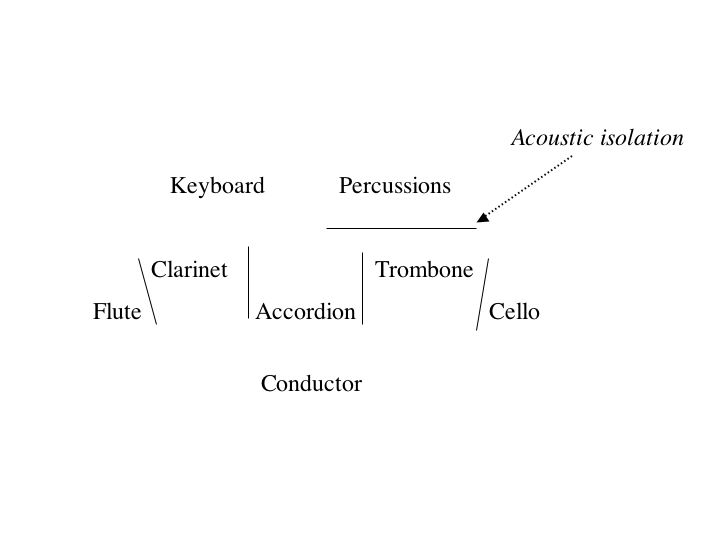
Patch informations:
Installation:
Copy the folder _PQD-2021-Max on your hard disk.
Launch max8, and select this folder (and only this one) in the ‘file preferences’ menu.
Open the file parisquidort2021.maxpat in max.
Open the file _PQD-2021-Reaper-210529 in reaper.
Max8 instructions:
Description of the main patch:
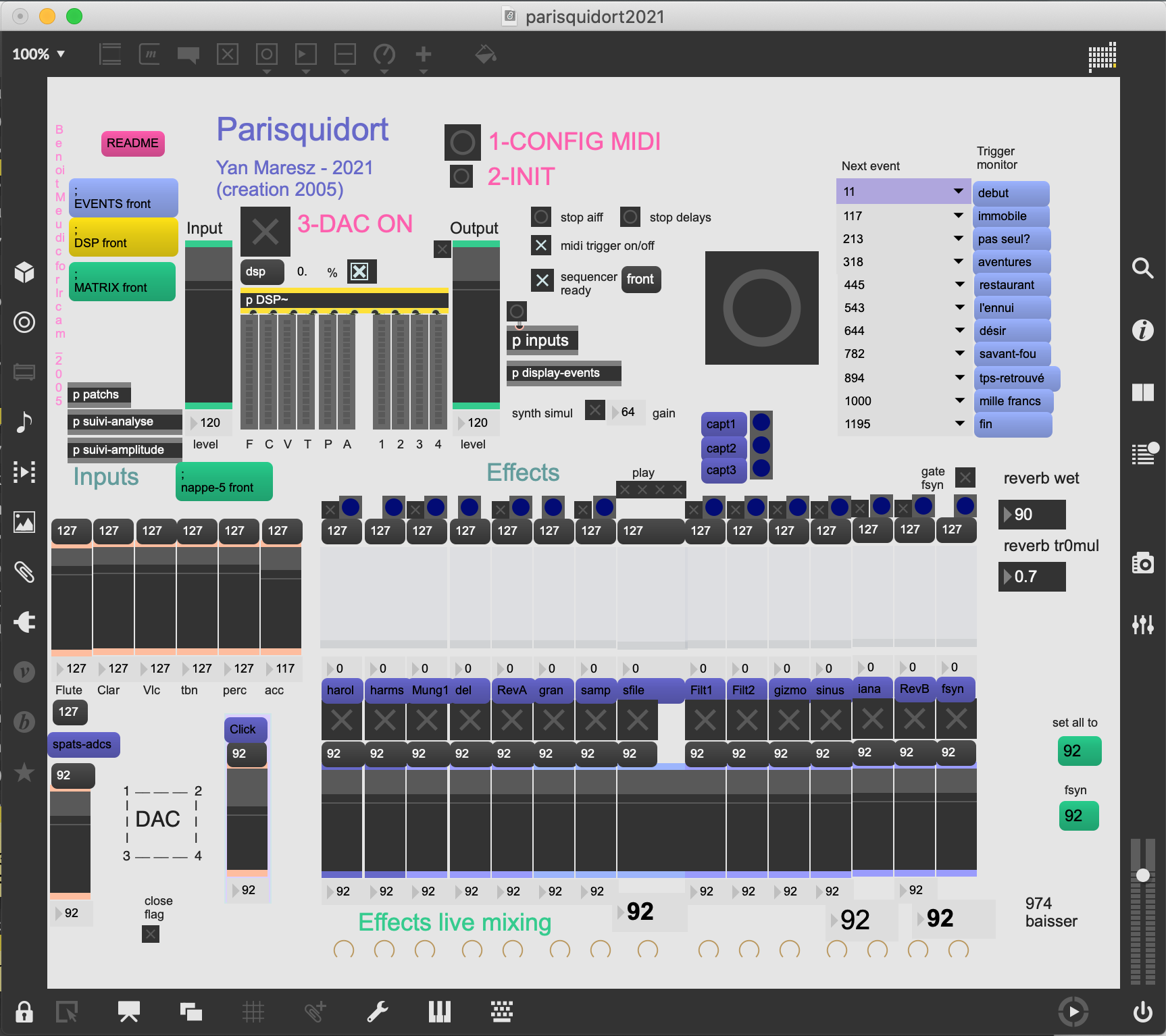
The concert patch is composed of:
- Top right: interface for events triggering. Events are represented by a unique number corresponding to the bar number of the instrumental score. The highlighted number in the menu corresponds to the next event that will be triggered. You can access to the instructions of the events by clicking on the blue message on the right of the event window.
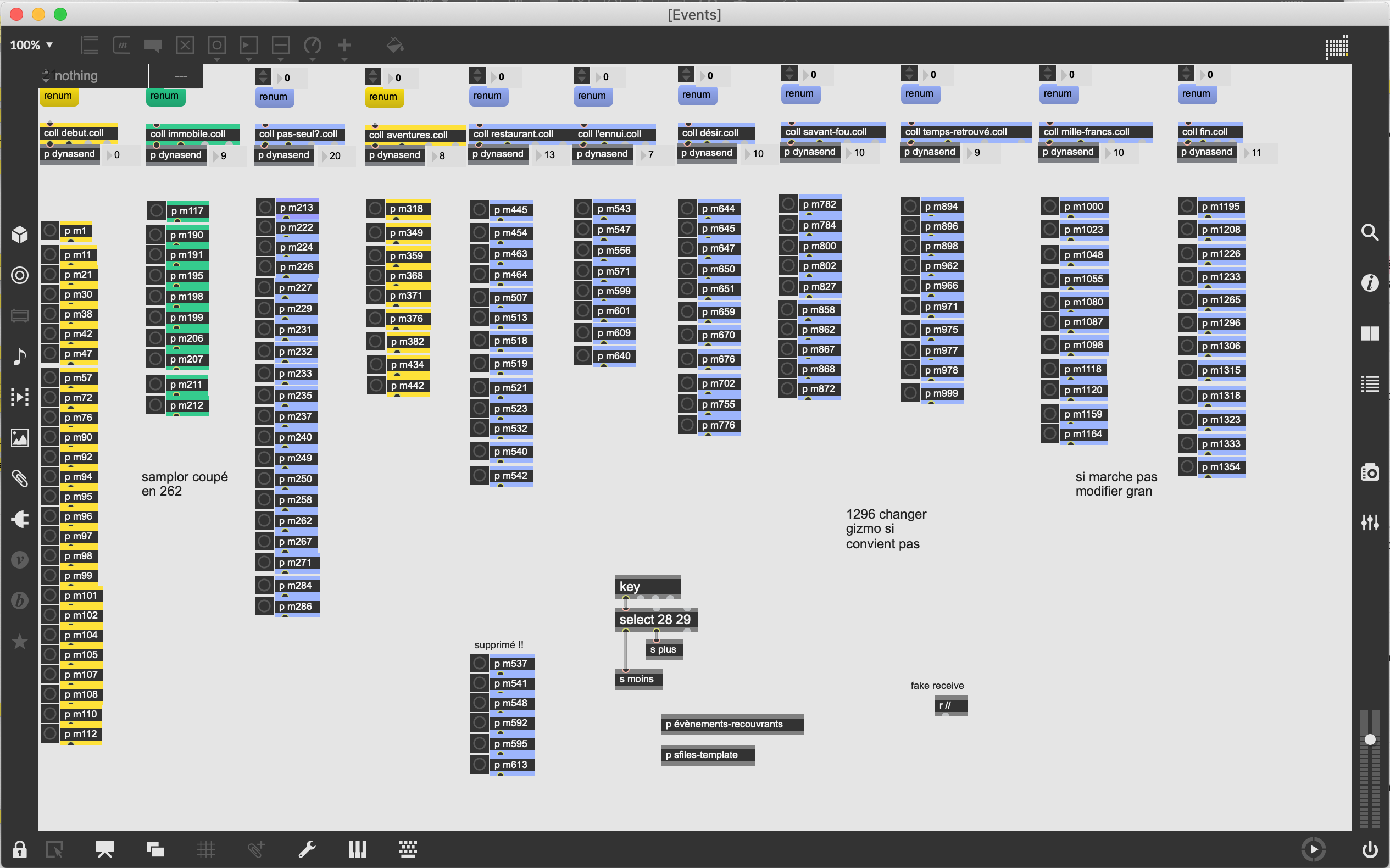
- Top middle: configuration interface (midi communication with reaper and mixing device)
- Top left: main sub-patchers (audio, midi, libraries, events counter, reset, matrix connections).
- Bottom: live mixing faders.
Inputs/Outputs:
There are 6 inputs: flute (fl), clarinet (cl), cello (vc), trombone (tbn), percussion (perc) and accordeon (acc).
There are 4 outputs for live electronics: dac 1..4 for loudspeakers 1, 2, 3 and 4
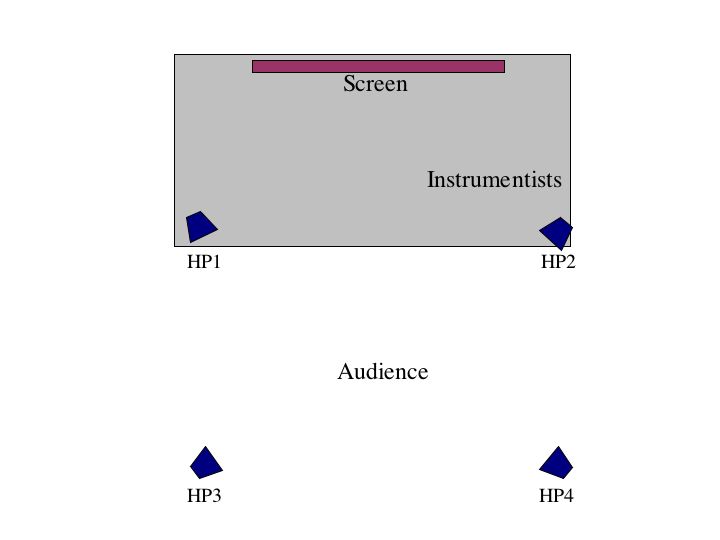
Receiving time code
Your audio interface should be connected to the timecode output of the DCP server so as to synchronize the start of the reaper session with the start of the movie.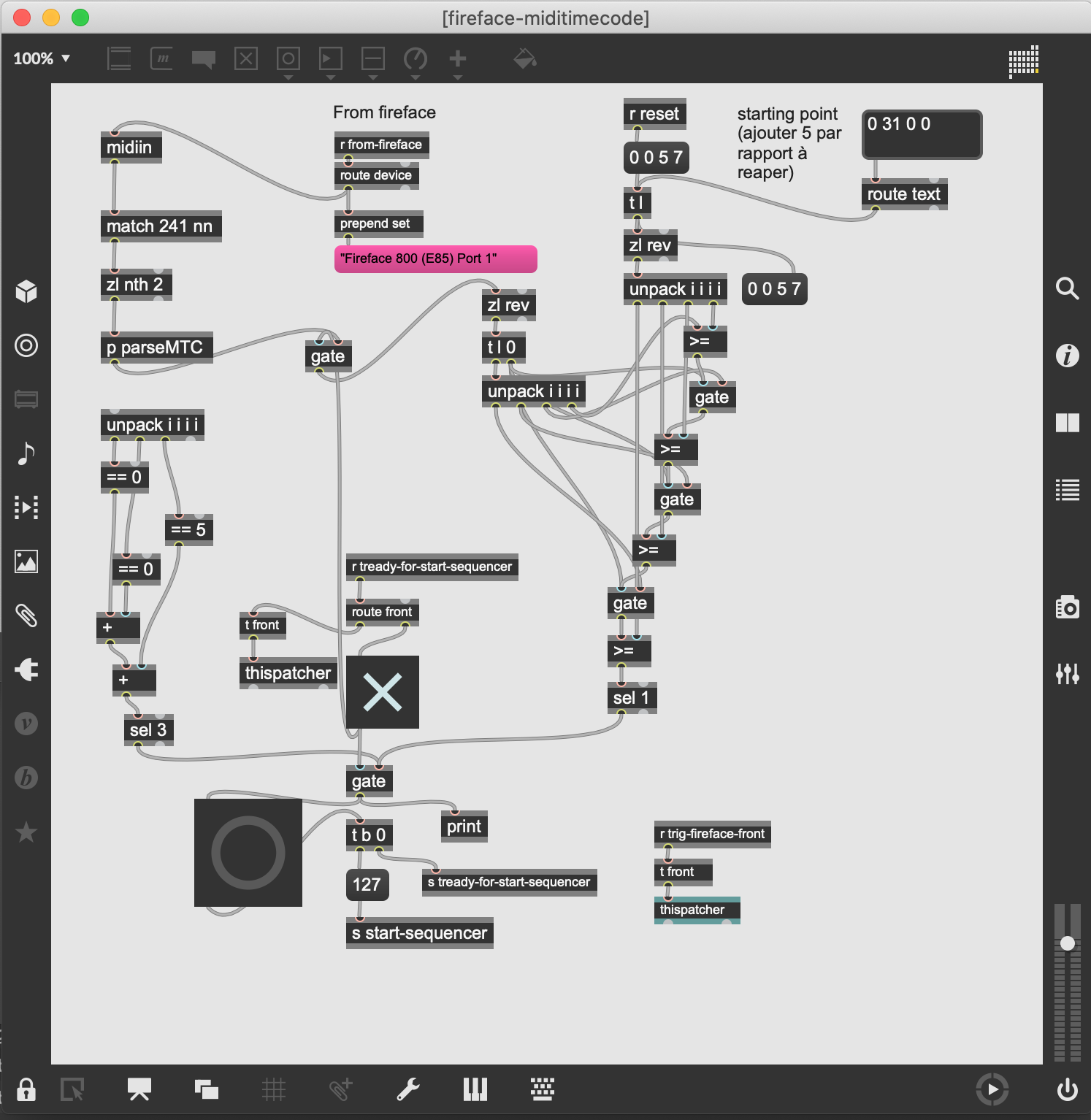
Mira instructions
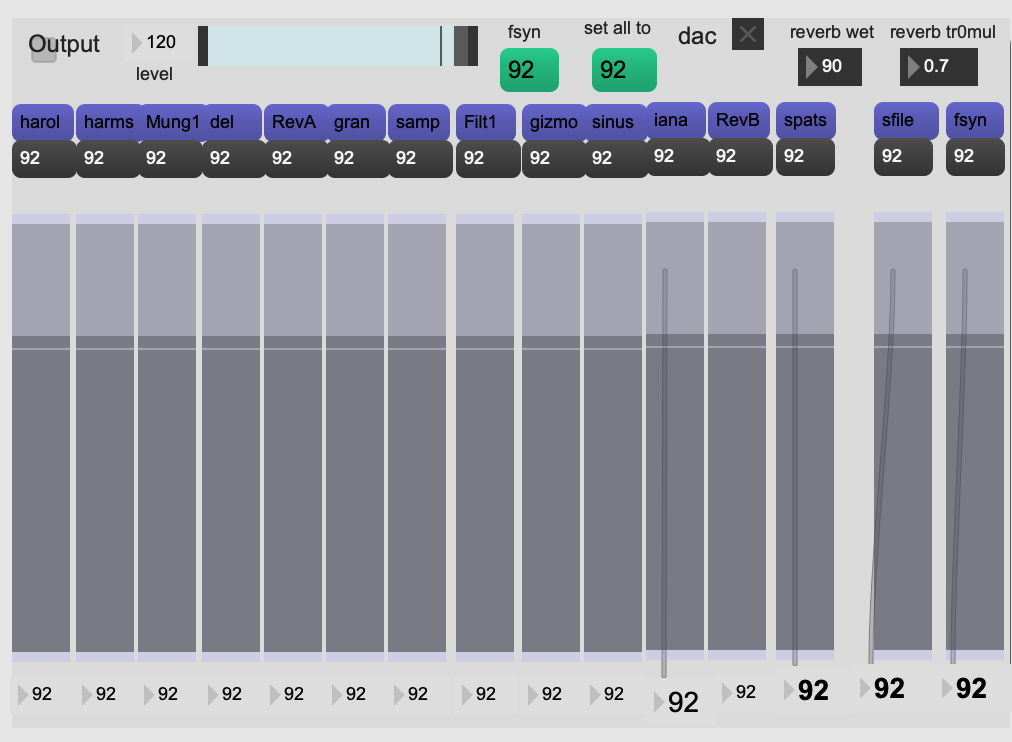
If you use an Ipad for mixing the electronics, you have to install Mira on it.
Then create a local wifi network from your computer and connect the ipad on it. Open Mira and connect to the computer network. The above window should be displayed on Mira.
Initialisation:
To initialize the patch:
- Click on ‘1-config midi’
Configure midi devices (reaper, audio device receiving timecode and optionaly mixing midi device)
Save the main patch. The configurations will be saved even if you quit max.
If you load the patch again, you will only have to load the sfiles in the ‘config patch’ window.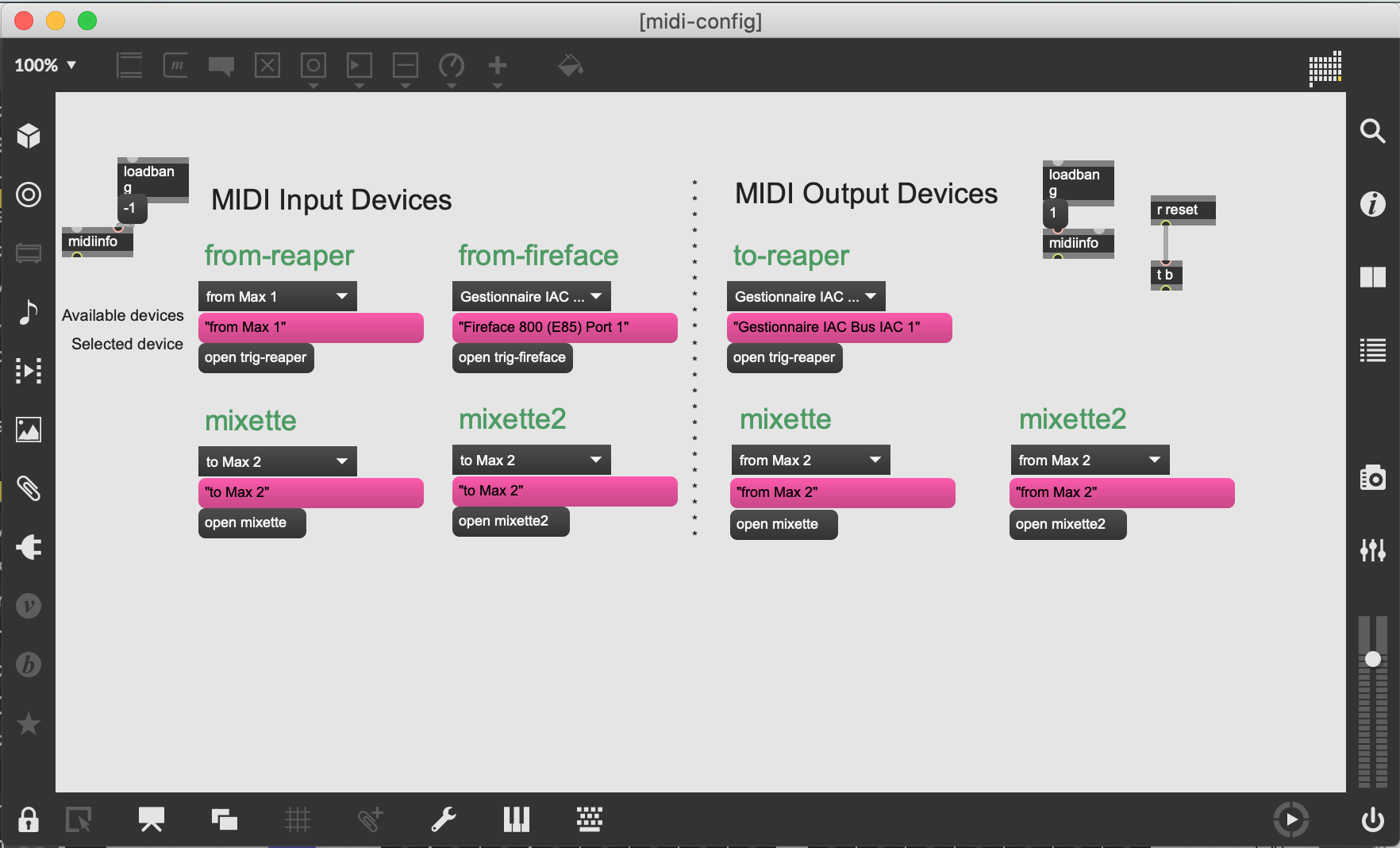
The controler numbers used to control the mix in reaper can be seen in the max window ‘reaper-midi’: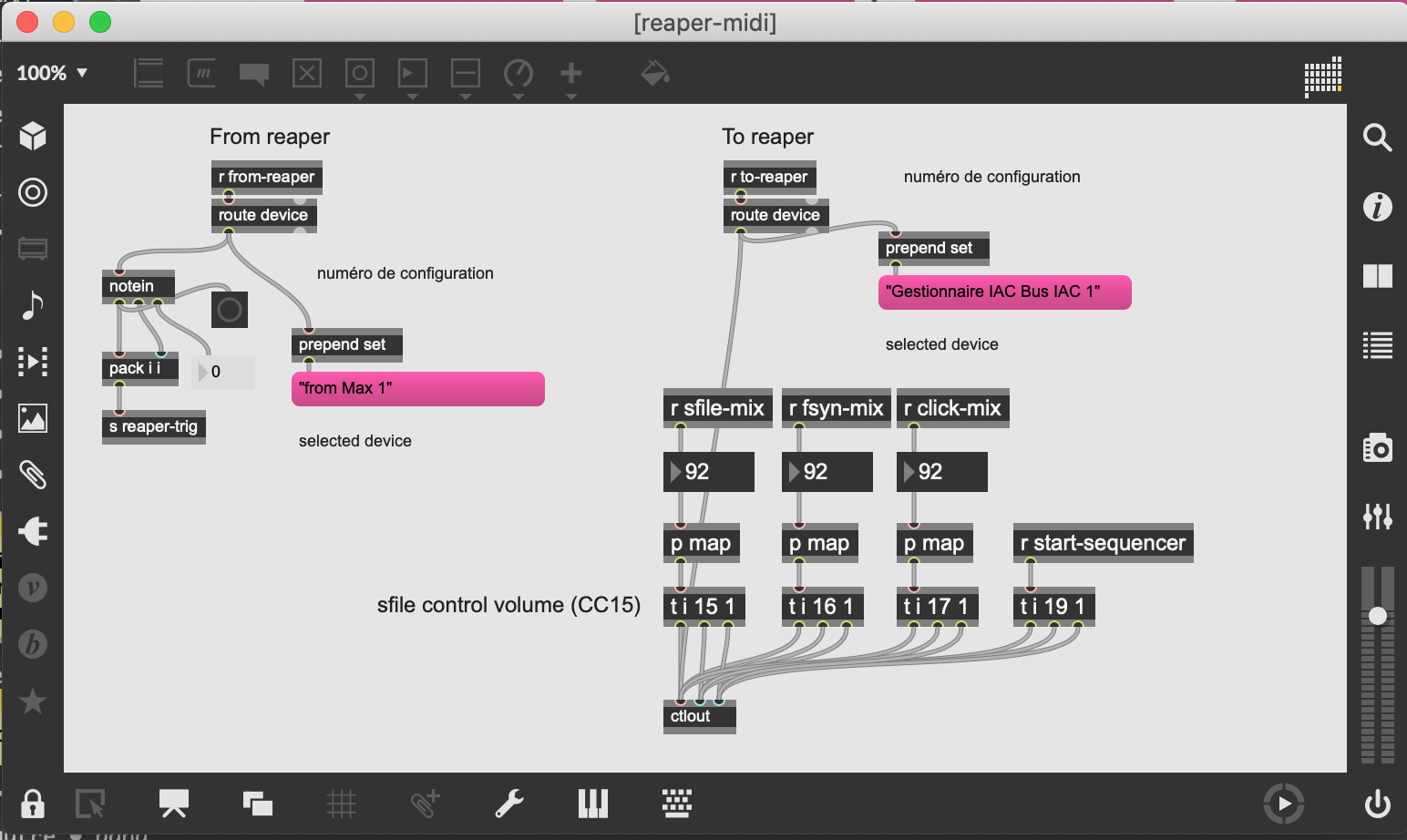
- Click on ‘2-init’ to reset the patch
The Dsp should be automatically set to sr 48kHz, IOvs 256 and svs 64.
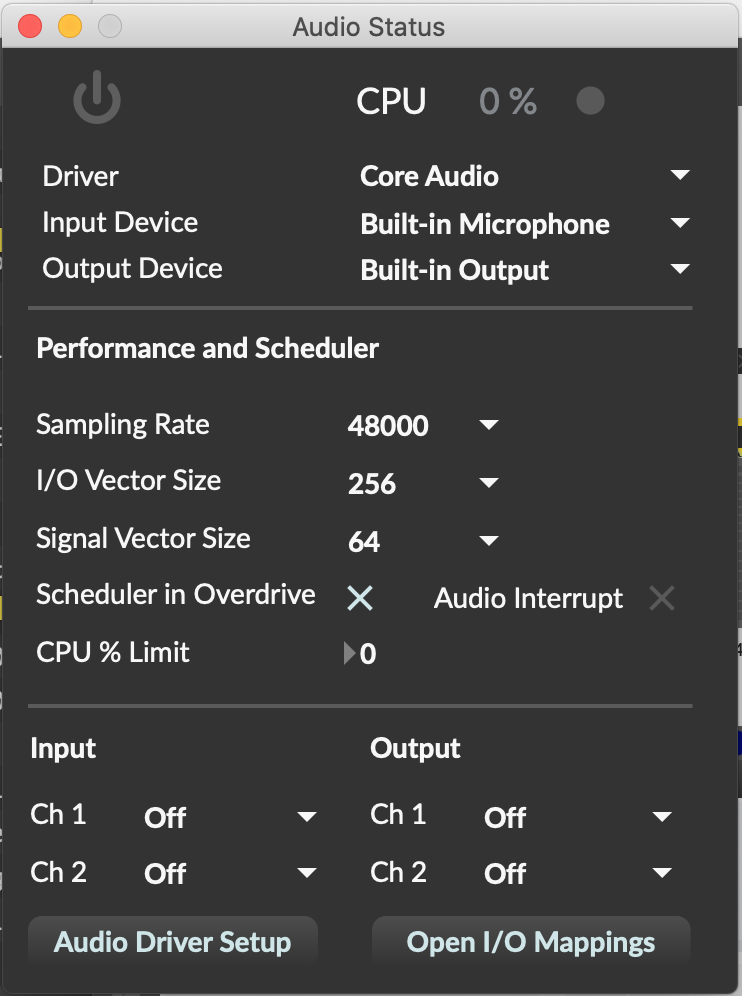
- turn the DAC on
The first time you use max8, before turning on the dac, you should choose the correct audio driver in the dsp window.
Reaper instructions:
Description:
Reaper is used to play the soundfiles, the click-track and the midi virtual instruments.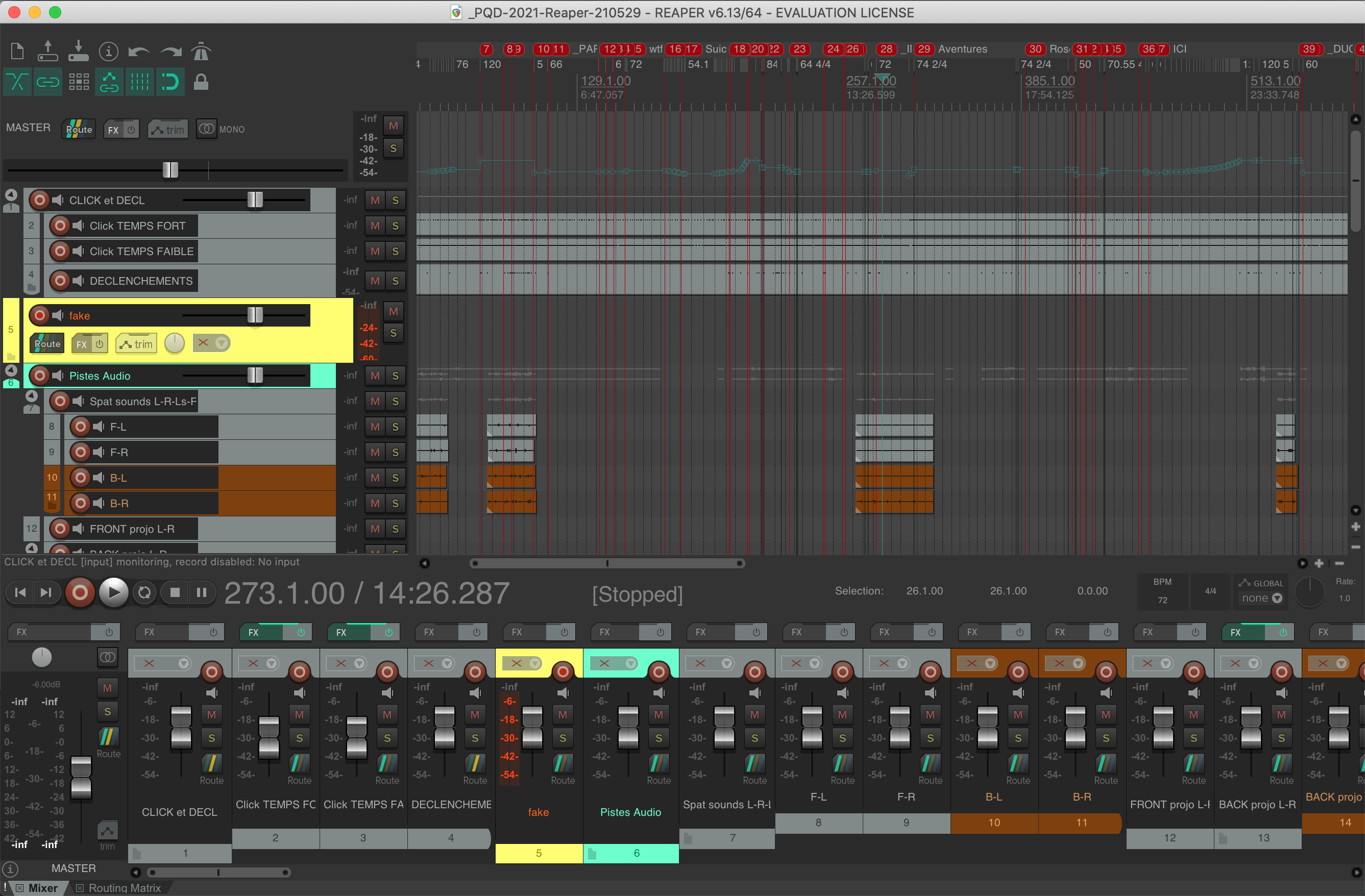
Inputs/Outputs:
The 4 first outputs are for for loudspeakers 1, 2, 3 and 4 and the fifth output is for click-track.
Initialisation:
In the reaper midi preference window, enable the max midi devices so that reaper can receive and send midi from max: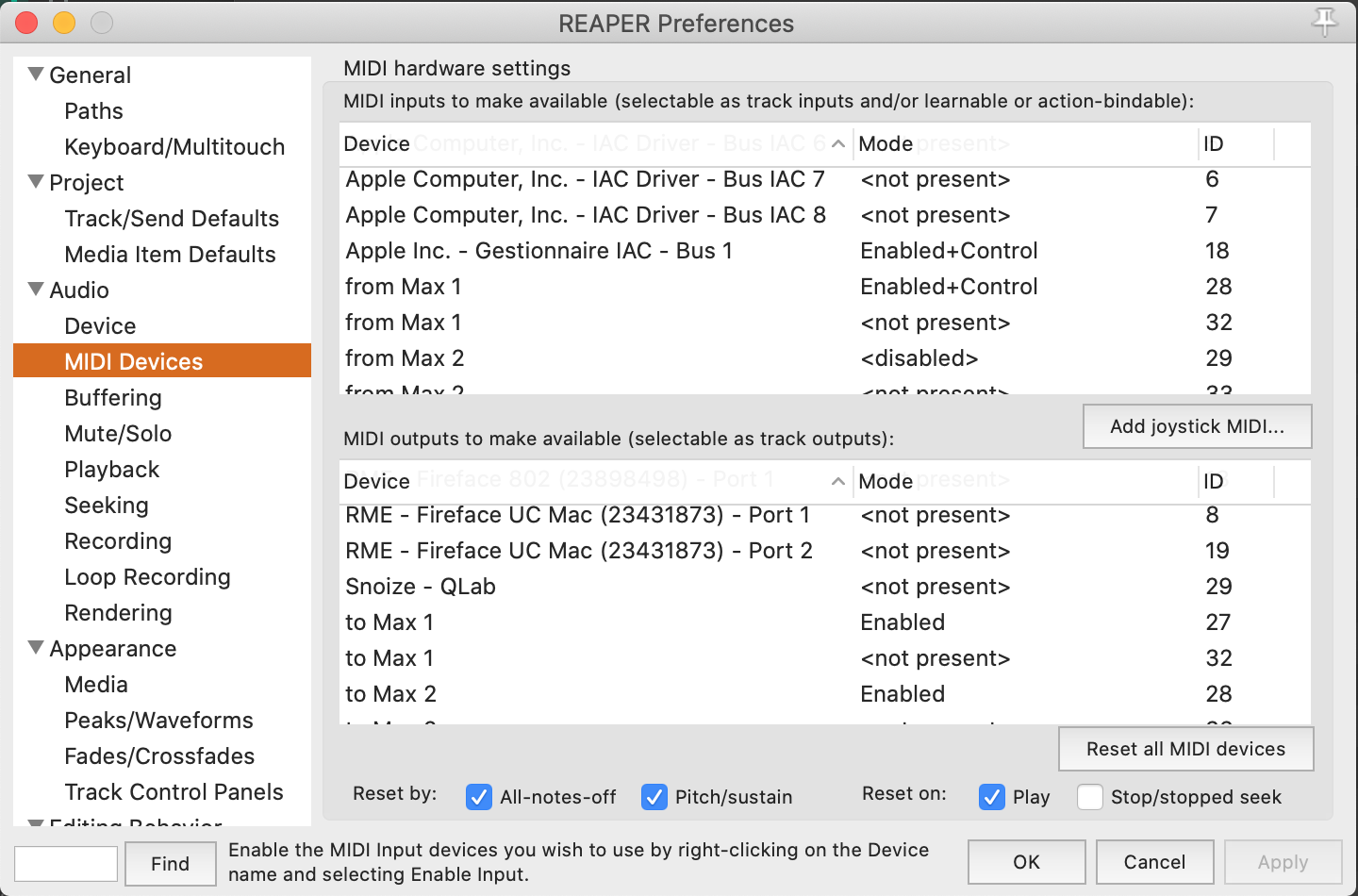
Configure the actions so that you control the gain of the main audio, click and midi tracks from max.
Configure the ‘transport play’ action so that reaper plays when receiving a value of controler 19 from Max.
To run the patches for the concert:
Before the concert:
Initialise the max8 patch, turn the dac on.
Rewind Reaper
Start the DSP movie.
When the time-code is positioned at (or superior to) 0 0 5 7 max8 should order the reaper session to play.
Mixing indications:
Levels of main treatments should be mixed in real time. Try to make both electronics and amplified sound as homogeneous as possible.
Benoit Meudic, May 2021
Ircam
© IRCAM

This documentation is licensed under a Creative Commons Attribution-NonCommercial-NoDerivatives 4.0 International License.
Program note
La musique pour l'accompagnement du film Paris qui dort est conçue comme un contrepoint à l'image avec le souci permanent de servir le film, quel que soit le niveau de complémentarité ou de divergence utilisé. Si elle est contrepoint au niveau temporel, elle est aussi « harmonisation » au niveau plus local, pour ce qui est de la psychologie des personnages. Elle est aussi « orchestration », en tant qu'extension dans le domaine des timbres de l'ambiance spécifique de chaque scène. Le déroulement formel général de la pièce est fourni par la trame cinématographique, et en ce sens, la musique suit assez fidèlement le découpage du film adoptant ainsi son articulation dynamique. Par contre, elle ne suit pas le montage avec précision, mais plutôt anticipe, commente, soutient ou entretient le rythme provoqué par celui-ci.
La thématique centrale d'une temporalité « contrariée », participe à créer autant de refuges « hors du temps », dans lesquels la psychologie humaine, non préparée à l'expérience d'une telle réalité, est explorée avec beaucoup d'ironie et d'humour par René Clair. Le musicien ne peut que se réjouir de cette thématique, car les situations engendrées par le jeu sur le « temps contrarié » dans son écoulement (pour certains seulement) comme le temps figé, ou accéléré, sont des situations éminemment musicales qui trouvent ici pour leur réalisation un espace de déploiement naturel et cohérent.
L'ensemble instrumental, assez inhabituel (flûte, clarinette, accordéon, violoncelle, trombone, percussion, clavier maître) possède une riche palette sonore me permettant d'obtenir la couleur spécifique que je recherchais. L'électronique en temps réel (analyse/synthèse, génération de structures rythmiques « spectrales », extraction des composants « bruitées » du spectre instrumental, transformations diverses, etc...) est utilisée de manière à enrichir et magnifier la matière sonore instrumentale.
Yan Maresz.
Version documentation creation date: 30 mai 2021 12:20, update date: 16 janvier 2022 15:48